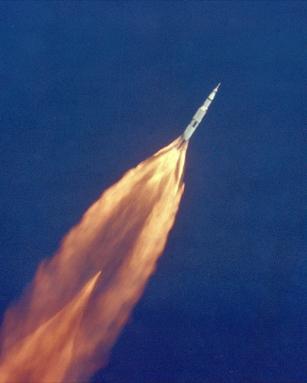 This week, Amazon.com founder and CEO Jeff Bezos announced a bold plan: to recover at least one of Apollo 11’s engines from the bottom of the Atlantic. The engines sunk to the briny deep after the Saturn V’s spent first stage jettisoned a little less than three minutes after launch on July 16, 1969. Bezos’ team of underwater experts armed with state-of-the-art sonar technology have located the engines, and he hopes to donate the recovered hardware to the Museum of Flight in Seattle. But NASA still owns the engines, and the agency gets to decide what happens to this piece of history, which may not even be form Apollo 11 at all. It’s an interesting proposal, and however Bezos’ plan for recovery unfolds, its sure to be interesting (particularly to historians). Check out my full article on Motherboard. (Left, Apollo 11 shortly after launch. The first stage’s five F-1 engines are responsible for the fiery trail the Saturn V is leaving across the sky. 1969.)
This week, Amazon.com founder and CEO Jeff Bezos announced a bold plan: to recover at least one of Apollo 11’s engines from the bottom of the Atlantic. The engines sunk to the briny deep after the Saturn V’s spent first stage jettisoned a little less than three minutes after launch on July 16, 1969. Bezos’ team of underwater experts armed with state-of-the-art sonar technology have located the engines, and he hopes to donate the recovered hardware to the Museum of Flight in Seattle. But NASA still owns the engines, and the agency gets to decide what happens to this piece of history, which may not even be form Apollo 11 at all. It’s an interesting proposal, and however Bezos’ plan for recovery unfolds, its sure to be interesting (particularly to historians). Check out my full article on Motherboard. (Left, Apollo 11 shortly after launch. The first stage’s five F-1 engines are responsible for the fiery trail the Saturn V is leaving across the sky. 1969.)

This should say that NASA *claims* to still own the engines. Last I checked, NASA staff don’t have the final say on how maritime salvage law works.
The fact that the press releases all say “Apollo 11 engines”, rather than “Apollo engines”, suggests to me that someone somewhere in the mix cares about the distinction. Whether it’s Bezos himself, of course I can’t say.
No one not in the know would have been interested if the news said “Saturn V engines”, so they made it “Apollo engines”. But to me it sounds a bit weird.
Wouldn’t it be great though, if not just that one engine was raised, but the whole buckled and bent first stage? There must be ways of doing that. Hire some crane vessels. Pump it full of air and lift it. Even if the hull is ripped open, insert a big balloon and inflate it. A used and weathered, twisted and wrinkled S1C stage would look great in NASM. Or whichever air and space museum.
(One could perhaps even see it as a symbol for NASA, once the vanguard of exploration, now getting less and less funding from the government…)
Amy, I believe you probably meant to write “Together, they generated 7.5 million pounds of thrust”, not 1.5 million. The mighty F-1 engines produces 1.5 million lbs thrust EACH.
Regardless of a minor proofreading error, I enjoy your columns. Keep up the good work.
– John (the nitpicker)